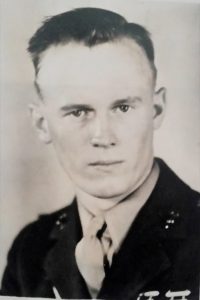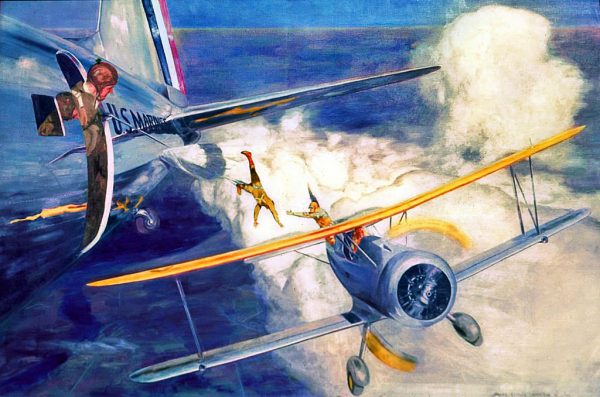World War II Chronicle: May 15, 1941
On this day, 9,040 Yankee fans endured a 13-1 trouncing from the Chicago White Sox at Yankee Stadium. Little did they know they witnessed a spectacular piece of baseball history. In the bottom half of the first inning, center fielder Joe DiMaggio singled to left field, knocking in Phil Rizzuto — his only hit and New York’s only run.

No one knew the significance of that play, but 9,000 disappointed fans would later realize they were there when Joe DiMaggio’s legendary 56-game hitting streak began…

Meanwhile to the east of San Diego, Calif., a Marine officer was in one heck of a tight spot. Serving as jumpmaster for a group of Marine parachutists, 2nd Lt. Walter S. Osipoff (featured image) had just sent 11 parachutists out the door and was about to join them when the Marines’ bundle of weapons and ammunition snagged Osipoff’s ripcord, sending his parachute out the door and pulling the Marine out of the R2D-1 transport (a Douglas DC-2). The weight of the 150-lb. cargo pack ripped open his left arm and shoulder before the lines tore away from Osipoff.
His parachute was destroyed and Osipoff was dangling upside-down from his lines 100 feet from the aircraft. The crew had no way of pulling the Marine back on board and there was no radio on the aircraft to alert the ground about the officer’s predicament. As the Douglas circled slowly over North Island’s naval air station, Navy Lt. William W. Lowrey spotted the dangling Marine and ordered Aviation Chief Machinist’s Mate John R. McCants to fuel up a SOC Seagull biplane for a daring rescue attempt before the Marine perished.
From HistoryNet:
As the R2D-1 passed over the naval air station on North Island, Lieutenant William Lowrey realized what was happening and ordered Aviation Chief Machinist’s Mate John McCants to fuel up a Curtiss SOC-1 Seagull biplane. He then phoned the control tower (the SOC also lacked a radio) and, racing to his aircraft, took off with McCants in the rear cockpit. Pacing the R2D-1, Lowrey maneuvered the Seagull up beneath Osipoff, but twice the wind dragged the Marine across the biplane’s wing. […]
At 3,000 feet Lowrey tried another pass as McCants stood in the rear cockpit. Working the biplane up, Lowrey got close enough for McCants to grab the Marine. But Osipoff remained enmeshed in the lines, and McCants was unable get him into the small rear cockpit. So Osipoff lay on top of the fuselage with a death grip on McCants.
As McCants worked desperately to cut the lines before the planes drifted apart, a wind gust bucked the Seagull, its propeller chopping nearly a foot off the transport’s tail cone fairing. It turned out to be a piece of luck. When the biplane’s nose came up, Osipoff’s tangled lines drooped across its upper wing, and the propeller neatly severed them.
Though his plane was encumbered with shroud lines, a fouled rudder and the weight of an extra passenger, Lowrey was nonetheless able to bring in the Seagull for a safe landing at North Island.
Osipoff had endured 33 minutes of twirling helplessly in a 110 mph wind and had suffered severe cuts and bruises and a fractured vertebra. He spent three months in a body cast but eventually recovered and returned to jump status. By war’s end he had served in the Pacific, been awarded a Bronze Star and reached the rank of lieutenant colonel.

Navy Secretary Frank Knox presented McCants and Lowrey with the Distinguished Flying Cross for their incredible rescue. You can find an audio interview with Osipoff at https://californiarevealed.org/islandora/object/cavpp%3A14733.
Click here for TODAY’S NEWSPAPER
Evening star. (Washington, D.C.), 15 May 1941. Chronicling America: Historic American Newspapers. Lib. of Congress.
https://chroniclingamerica.loc.gov/lccn/sn83045462/1941-05-15/ed-1/
